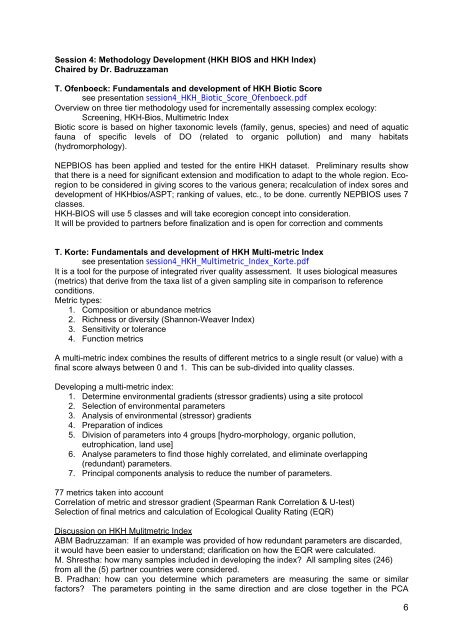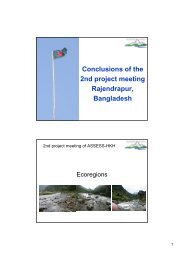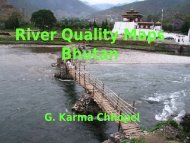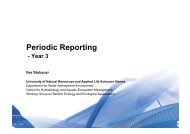2007 - ASSESS-HKH
2007 - ASSESS-HKH
2007 - ASSESS-HKH
You also want an ePaper? Increase the reach of your titles
YUMPU automatically turns print PDFs into web optimized ePapers that Google loves.
Session 4: Methodology Development (<strong>HKH</strong> BIOS and <strong>HKH</strong> Index)<br />
Chaired by Dr. Badruzzaman<br />
T. Ofenboeck: Fundamentals and development of <strong>HKH</strong> Biotic Score<br />
see presentation session4_<strong>HKH</strong>_Biotic_Score_Ofenboeck.pdf<br />
Overview on three tier methodology used for incrementally assessing complex ecology:<br />
Screening, <strong>HKH</strong>-Bios, Multimetric Index<br />
Biotic score is based on higher taxonomic levels (family, genus, species) and need of aquatic<br />
fauna of specific levels of DO (related to organic pollution) and many habitats<br />
(hydromorphology).<br />
NEPBIOS has been applied and tested for the entire <strong>HKH</strong> dataset. Preliminary results show<br />
that there is a need for significant extension and modification to adapt to the whole region. Ecoregion<br />
to be considered in giving scores to the various genera; recalculation of index sores and<br />
development of <strong>HKH</strong>bios/ASPT; ranking of values, etc., to be done. currently NEPBIOS uses 7<br />
classes.<br />
<strong>HKH</strong>-BIOS will use 5 classes and will take ecoregion concept into consideration.<br />
It will be provided to partners before finalization and is open for correction and comments<br />
T. Korte: Fundamentals and development of <strong>HKH</strong> Multi-metric Index<br />
see presentation session4_<strong>HKH</strong>_Multimetric_Index_Korte.pdf<br />
It is a tool for the purpose of integrated river quality assessment. It uses biological measures<br />
(metrics) that derive from the taxa list of a given sampling site in comparison to reference<br />
conditions.<br />
Metric types:<br />
1. Composition or abundance metrics<br />
2. Richness or diversity (Shannon-Weaver Index)<br />
3. Sensitivity or tolerance<br />
4. Function metrics<br />
A multi-metric index combines the results of different metrics to a single result (or value) with a<br />
final score always between 0 and 1. This can be sub-divided into quality classes.<br />
Developing a multi-metric index:<br />
1. Determine environmental gradients (stressor gradients) using a site protocol<br />
2. Selection of environmental parameters<br />
3. Analysis of environmental (stressor) gradients<br />
4. Preparation of indices<br />
5. Division of parameters into 4 groups [hydro-morphology, organic pollution,<br />
eutrophication, land use]<br />
6. Analyse parameters to find those highly correlated, and eliminate overlapping<br />
(redundant) parameters.<br />
7. Principal components analysis to reduce the number of parameters.<br />
77 metrics taken into account<br />
Correlation of metric and stressor gradient (Spearman Rank Correlation & U-test)<br />
Selection of final metrics and calculation of Ecological Quality Rating (EQR)<br />
Discussion on <strong>HKH</strong> Mulitmetric Index<br />
ABM Badruzzaman: If an example was provided of how redundant parameters are discarded,<br />
it would have been easier to understand; clarification on how the EQR were calculated.<br />
M. Shrestha: how many samples included in developing the index All sampling sites (246)<br />
from all the (5) partner countries were considered.<br />
B. Pradhan: how can you determine which parameters are measuring the same or similar<br />
factors The parameters pointing in the same direction and are close together in the PCA<br />
6






